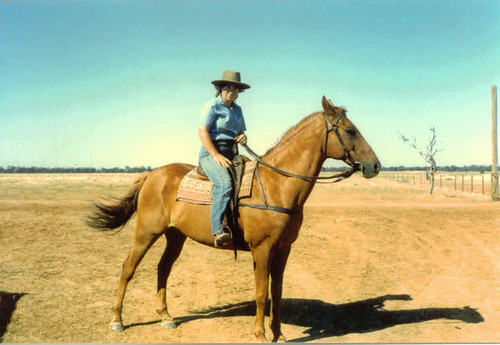.flickr-photo { border: solid 2px #000000; }.flickr-yourcomment { }.flickr-frame { text-align: left; padding: 3px; }.flickr-caption { font-size: 0.8em; margin-top: 0px; }
My resolution never to go into television journalism was formed early, when I went out drinking with a local TV newsreader. I had to run interference for her all evening in a nightclub, as drunken people who thought she was their friend because she was in their living room every night came to pour out their troubles to her.
Consequently, even though I’m sure my readers are a far more distinguished lot, I haven’t got a picture of myself on this blog, but I reckon I’m safe enough posting this nearly two decade-only pic of me on a very good polocrosse horse who knew I wasn’t a good enough rider for him. It was taken on a property west of Nyngan (western NSW).
And it does nicely illustrate for those who haven’t seen it the sort of country that Jill Ker Conway describes growing up in, near Lake Cargelligo in western NSW, in her The Road from Coorain.
I mentioned previouslyher excellent advice on difficult partings.
This book speaks a lot to me on many levels – although I didn’t grow up in the bush and am the next generation there’s many echoes of my family in her circumstances – but what I want to talk about here is her view of Australian, specifically Sydney, society in the 1950s.
“The most interesting circle at the University [Sydney, then the only one] revolved around the philosophy and political science departments, and a small coterie of gifted faculty and students who were iconoclasts, cultural rebels and radical critics of Australian society. I liked their ideas, and enjoyed the fact that their circle also contained journalists and serious writers about Australian politics.” (Interesting distinction made there!)
She complains, however, that in this group it was obligatory to reject “bourgeois conventions” of sexuality by sleeping with many different people, and that the women were doing all of the housework, childcare, etc, while the men did all the fun and glory-generating stuff.
“I came to see that their position of isolation from the mainstream of Australian society was an unhappy and paralyzing one. There was no social group on which cultural radicals could base a program of action in Australia. …We might spend all the time we liked discussing McCarthyism in the United States and the antidemocratic tendencies of Catholic Action in Australia, but there was no one waiting for our pronouncements … My radical friends were isolated and alientated, more like a religious sect within an uncaring secular society than their models, the European intelligentsia who labored intellectually in a world where ideas mattered. (p. 220-222)
Funny, or I might say tragic, how that reflects Australia in 2005. There were patches of advances, in the Seventies, Eighties and Nineties, but my impression of Australia now is that it is closer to the Fifties than any of those better decades.


 About
About
5 Comments